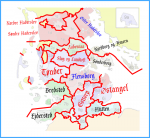- Location
- Das Böse ist immer und überall
- Pronouns
- he/him
Certainly are. It's a thing of beauty, isn't it?Are those parish boundaries?
Certainly are. It's a thing of beauty, isn't it?Are those parish boundaries?
Certainly are. It's a thing of beauty, isn't it?
...and finally, the 8 borough seats, which I have outsourced to @Ares96 as I feel I am getting dangerously close to going mad or dying at this point...

And a few sacred cows later, here we are.

The lower chamber of the Unionsdag has 528 seats as of the inaugural election, which divide among the constituent countries as follows:
Sweden 198 (154 country, 44 burgher)
Denmark proper 95 (58 country, 37 burgher)
- Slesvig 19 (14 country, 5 burgher)
- Holsten-Lauenborg 28 (19 country, 9 burgher)
Norway 84 (61 country, 23 burgher)
Finland 82 (72 country, 10 burgher)
Pomerania 10 (8 country, 2 burgher)
Iceland 3 (elected indirectly by Althing)
Faroe Islands 1
Union County of Gothenburg 8



The big map is a thing of beauty guys, just one question, what is the electoral system for the multi-member districts? Block voting? SNTV?
SNTV on the countryside.
In Gothenburg, they kind of in a sense do have electoral "districts", but not based on geographical location, but based on profession. Like, all grocers vote in the same electoral "district", so to speak, and so on. Within these districts, they do SNTV.
Complete and total fucking madness in Stockholm as they are refusing to abolish their system of electors.
I'll just crosspost your own post from back in 2014 on how that worked, because it deserves to be seen:Complete and total fucking madness in Stockholm as they are refusing to abolish their system of electors.
How you Elect Representatives to the Estate of the Burghers of the Swedish Riksdag:
All cities are legally compelled to adopt a system as close to that of Stockholm which is described below, with certain guidelines as to how far they are allowed to depart from it.
It is to be declared before the council house and in all the churches that there is on the appointed date to be a general election, and on that date every burgher of the city is to come to the council house for the vote. A burgher is a person who is either an official or has received a charter to do commerce in the city[1] and has paid his or her tax to the crown and the borough. If you do not come, your vote will be considered forfeited.
At the council house, the voters are now to be divided into forty-eight classes according to their trade, wealth and position. There are to be twenty-four classes of people involved in commerce and twenty-four of those who are officials and civil servants. Each class elects one elector. Of those twenty-four elected by the merchants, twelve are to be grocers, and twelve are to be of the other trading guilds. There are specific rules regarding the eligibility to be elected an elector: You have to have been born in Sweden, you have to have lived in the city and been a burgher for a minimum of seven years.
Now these forty-eight electors are to elect the ten representatives of the city. This is done in the following fashion:
Six are elected by block-vote, wherewith the grocers have two votes, those of the other guilds have one vote, and the officials have three votes. Those six with the greatest numbers of votes have then become elected representatives. Interestingly, the law stipulates that this election is to be by secret ballot.
Now, in order to ensure a specific representation by the magistrate of the city, the forty-eight electors are to nominate six candidates out of the mayor and the council. Once these six candidates have been nominated, the magistrate are to elect four of these. The four of these to receive most votes are now become elected representatives as well.
And that is how you elect your Third Estate MPs!
[1] This mercantilist rule actually meant that women could in theory be allowed to vote, and in some places, like Kristianstad, they actually did and played prominent political roles.
Wait so then it's the local areas that determine franchise?
This was true in England vs Scotland in the 1600s-1700s; Scotland, which had a more restrictive franchise, also had much lower turnout.Looking over the old statistics for Sweden, it is remarkable how poor voter turnout actually was even for the very limited suffrage.
The fact that anybody remembers those crummy graphics actually makes me feel like I'm dissociating.With apologies to moth...
View attachment 4898
Nicholas Andersen
20 July 1867 – 18 September 1876
Radikale Højre
"Friends of the Union" Composition Majority Government
The Great Reunifier
The fact that anybody remembers those crummy graphics actually makes me feel like I'm dissociating.
Good stuff.
So, after some discussion with @Ares96 we have decided to reduce the suffrage in Sweden, Denmark, and Norway to the figure of a mere 10% of the population, after looking at the actual suffrage at the time (which was around 5%) and concluded that 10% is in all likelihood the most generous number we can have within the bounds of what we ourselves consider reasonably plausible for our purposes.
Norway fares a little better with 15%.
Looking over the old statistics for Sweden, it is remarkable how poor voter turnout actually was even for the very limited suffrage. In many constituencies, we're talking about only a couple of hundred people actually bothering going to the ballot box. In a few, we're actually only looking at a little over one hundred people actually voting.
We'll probably have better voter turnout here, but that being said, I doubt there will be particular many of those 24,000-ish people constituency where they ever actually record more than, say, 2,000 votes in total.
We'll probably have better voter turnout here, but that being said, I doubt there will be particular many of those 24,000-ish people constituency where they ever actually record more than, say, 2,000 votes in total.
Yeah, the document we got the figures for Sweden from also showed proportion of legal adult males (the only legal adult women being widows and unmarried women above 25 at this point) to the general population, and it was generally in that neighbourhood.That sounds about right. As part of the research for the Spanish 1869 election, I noticed that even though it had "universal" male suffrage for the over 25 (21 after 1873), that meant just 25-27% of the total population. So indeed, your numbers do make more sense now.
Yeah, the document we got the figures for Sweden from also showed proportion of legal adult males (the only legal adult women being widows and unmarried women above 25 at this point) to the general population, and it was generally in that neighbourhood.
